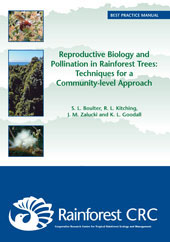 |
||||
 |
Back to Research Report Series |
|||
| Report
No. 47 Reproductive Biology and Pollination in Rainforest Trees: Techniques for a Community-level Approach Best Practice Manual S. L. Boulter, R. L. Kitching, J. M. Zalucki and K. L. Goodall ISBN 0 86443 763 3 |
||||
| Extract
from Introduction The process of pollination is fundamental to the long-term sustainability of a plant. It is through pollination that seed set occurs and on which depends the genetic future of the individual. Ultimately, these interactions are expressed in the phenology and flower morphology we can identify for each plant. Plants have more reproductive options than do most animals. They can reproduce vegetatively: essentially perpetuating almost the exact genome of the parent tissues (apart, presumably, from a few mitotic copying errors). They can reproduce sexually from gametes, which they themselves produce ('selfing'), resulting in a remixed genome which will, on average, but not individually, be identical with that of the parent. Lastly, they can do as most animals do: reproduce sexually by outcrossing with a different individual of a greater or lesser level of relatedness to the focal plant. The science of pollination biology has focussed substantially on this process of outcrossing and the agencies that facilitate the gene transfer involved. In 1998, the Rainforest CRC successfully attracted funding to establish the Australian Canopy Crane Research Facility. Subsequently, a fixed tower crane was erected in the lowland rainforest of the Daintree in North Queensland. This structure provides complete three-dimensional access to a hectare of primary (although cyclone-impacted) lowland rainforest. This has become the local focus of pollination research by Program 3, and the place where researchers have performed experimental manipulations of selected target species. This manual summarises the techniques Program 3 researchers have used since 1998. They have approached the manual by first describing techniques for studying the flora and flowers, and include accounts for studying animal associates of flowers before moving on to techniques designed specifically to examine the animal-plant interactions. A brief account of the physiological and genetic techniques theyhave used to support their field studies follows. The manual concludes by discussing the technical aspects of assessing the conservation implications of Program 3 studies. This manual is intended
as a resource for other researchers and students of rainforest plant
reproductive ecology, land managers wishing to understand the reproductive
ecology of forested areas under their care, and landholders wishing
to better understand native crop pollinators. |
 |
|||
|
See below left to download sections. |
||||
| Back to top | ||||
 |
||||